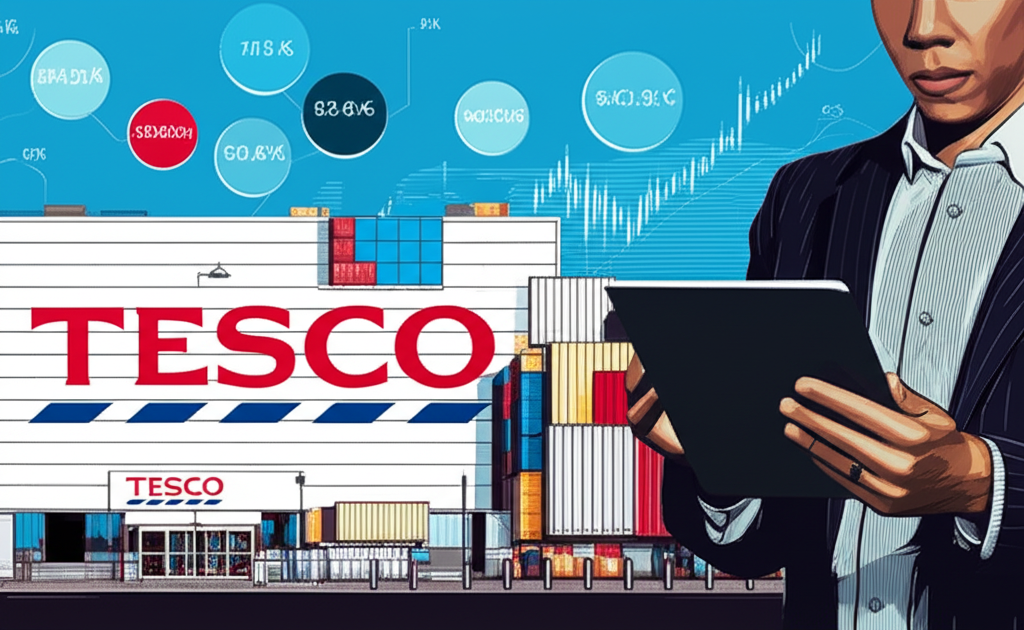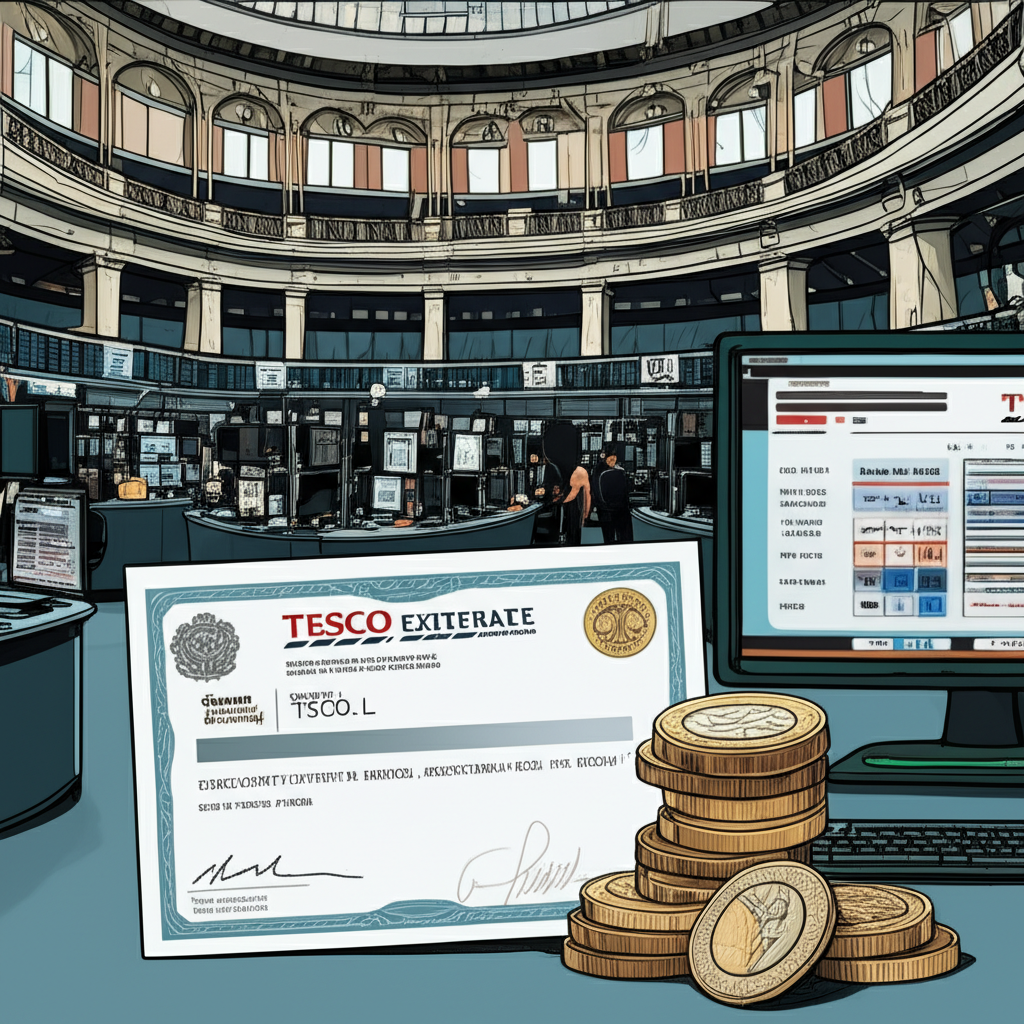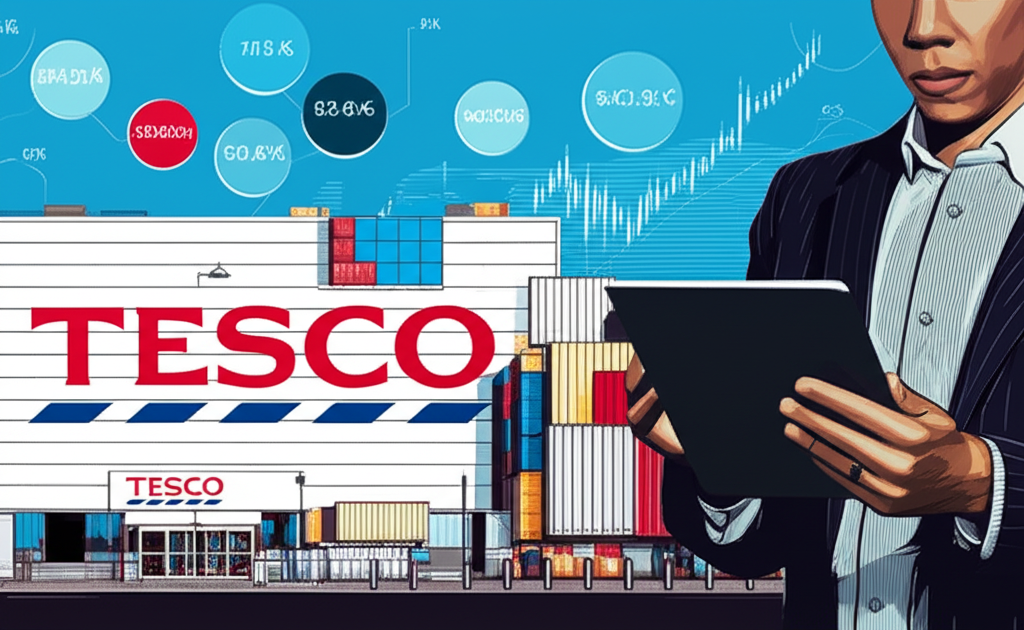Introduction: Understanding Tesco and Its Stock
Tesco PLC reigns as one of the most influential forces in global retail, with its sprawling network of supermarkets anchored firmly in the United Kingdom and extending into select European markets. As the UK’s largest grocery retailer, Tesco serves millions daily, offering everything from fresh produce and pantry staples to apparel, electronics, and household essentials. Its omnipresence in British consumer life underscores its economic significance and stability—a compelling proposition for international investors seeking exposure to a mature yet resilient sector.
For US-based investors aiming to diversify beyond domestic equities, adding a well-established international player like Tesco can enhance portfolio balance. The company’s steady operations, consistent dividend payouts, and adaptability to shifting retail trends make it a noteworthy contender in cross-border investment strategies. However, navigating how to access Tesco stock from the US requires understanding the dual pathways available: direct ownership via the London Stock Exchange or through an American Depository Receipt (ADR). This guide breaks down both options, outlines a clear purchasing process, and explores the financial, tax, and strategic considerations essential for informed decision-making.

Tesco Stock Basics: TSCO.L vs. TSCDY (ADR)
American investors interested in Tesco have two primary routes to ownership, each with distinct advantages and operational nuances. Understanding these differences is critical before placing any trade.

What is TSCO.L?
TSCO.L is the ticker symbol for Tesco PLC shares listed on the London Stock Exchange (LSE), representing the company’s primary listing. When you purchase TSCO.L, you’re buying ordinary shares in a UK-domiciled corporation, priced and traded in British Pounds (GBP). This route grants direct equity ownership, meaning you hold the actual shares and are subject to UK market regulations, settlement cycles, and trading hours (typically 8:00 AM to 4:30 PM GMT).
Investing directly in TSCO.L often requires a brokerage platform with international trading capabilities. Transactions involve currency conversion from USD to GBP, which may incur foreign exchange fees. While this method offers full exposure to the underlying asset, including voting rights and direct dividend receipts (before withholding taxes), it demands greater attention to exchange rate fluctuations and cross-border trading logistics.
What is TSCDY? (Tesco ADR)
For investors prioritizing convenience, Tesco’s American Depository Receipt, traded under the ticker TSCDY, provides a streamlined alternative. ADRs are issued by US banks and represent ownership in foreign shares, allowing non-US companies to be traded on American markets—or in Tesco’s case, the US over-the-counter (OTC) market.
Each TSCDY ADR represents a fraction of one ordinary Tesco share and trades in US dollars during regular US market hours. This structure eliminates the need for individual currency conversions and simplifies the trading experience, making it accessible through most standard US brokerage accounts. While ADR holders don’t receive physical shares or direct voting rights, they do benefit from dividend distributions—net of any foreign taxes withheld at the source.
Although ADRs mirror the performance of the underlying LSE-listed stock, minor pricing discrepancies can occur due to timing differences, currency movements, or administrative fees charged by the depository bank. Nonetheless, TSCDY remains a popular choice for US investors seeking low-friction access to Tesco without navigating international exchanges.

How to Buy Tesco Stock: A Step-by-Step Guide for US Investors
Acquiring Tesco stock as a US investor is a manageable process once you understand the steps involved. Whether you choose TSCO.L or TSCDY, the following framework ensures a smooth entry into your investment.
Step 1: Choose a Reputable Brokerage Account
The foundation of any successful international investment begins with selecting the right brokerage. Not all platforms offer equal access to foreign markets or ADRs, so it’s crucial to evaluate your options carefully.
Key factors to consider include:
- Market Access: Confirm whether the broker supports trading on the London Stock Exchange for TSCO.L or offers OTC access for TSCDY.
- Fees and Commissions: Look for competitive pricing on international trades, currency conversion, and ADR-related charges such as custody fees or dividend processing fees.
- Platform Usability: A user-friendly interface, real-time data, research tools, and responsive customer support can significantly enhance your investing experience.
Top-tier brokers that accommodate Tesco investments include:
- Interactive Brokers: Offers direct access to over 125 global markets, including the LSE, with low FX fees and robust research tools—ideal for active international traders.
- Fidelity and Charles Schwab: Both support ADR trading (including TSCDY) and offer limited direct international trading, making them suitable for long-term investors.
While platforms like eToro may list certain international stocks, availability of TSCO.L or TSCDY varies, so always verify. Meanwhile, Robinhood and Public generally restrict trading to US-listed securities and do not support direct LSE access or OTC ADRs.
Step 2: Fund Your Brokerage Account
Once your account is open and verified, deposit funds using one of several standard methods:
- ACH Transfer: The most common and cost-effective way to move money from your US bank to your brokerage, typically taking 1–3 business days.
- Wire Transfer: Faster than ACH but may come with bank-imposed fees; ideal for larger deposits.
- Check Deposit: Accepted by some brokers but involves extended processing times and is less commonly used today.
Ensure your account has sufficient funds to cover both the share cost and associated fees, especially if purchasing TSCO.L, where foreign exchange spreads may add to the total expense.
Step 3: Locate Tesco Stock
With funds in place, navigate to your brokerage’s trade execution page and search for the appropriate ticker:
- Enter
TSCO.Lto find Tesco’s ordinary shares on the London Stock Exchange. - Search for
TSCDYto locate the ADR trading over-the-counter in USD.
Before placing an order, confirm the displayed stock details—such as currency, exchange, and company name—to avoid accidental trades. Most platforms will show real-time pricing, trading volume, bid-ask spreads, and recent news to help inform your decision.
Step 4: Place Your Order
After confirming the correct listing, decide on the type of order that aligns with your strategy:
- Market Order: Executes immediately at the prevailing market price. Best for investors prioritizing speed over precise price control, though slight slippage may occur.
- Limit Order: Allows you to set a maximum price you’re willing to pay per share. This protects against sudden price spikes and is particularly useful in volatile markets or when trading during overlapping US/UK hours.
Specify the number of shares or ADRs you wish to buy, review all details—including total cost and fees—and submit your order. Execution time depends on market conditions and the exchange involved.
Step 5: Monitor Your Investment
Once your purchase is confirmed, you become a shareholder in one of Europe’s most enduring retail institutions. But investing doesn’t end at the point of purchase. Regular monitoring is essential.
Track Tesco’s financial reports, press releases, and industry developments through your brokerage platform, financial news outlets, or the company’s investor relations portal. Many brokers offer customizable alerts for price changes, earnings announcements, and dividend distributions. Staying engaged allows you to respond proactively to shifts in performance, competitive dynamics, or macroeconomic trends affecting the retail landscape.

Is Tesco Stock a Good Investment? Key Considerations
Evaluating Tesco as an investment involves more than checking its current price or dividend yield. A holistic view of its business model, competitive strengths, and risk profile is necessary.
Tesco Company Overview and Market Position
As the UK’s leading supermarket chain, Tesco commands approximately 27% of the grocery market, operating over 3,500 stores across the country. Its retail footprint spans hypermarkets, supermarkets, convenience stores, and online delivery hubs, ensuring broad consumer reach. Beyond food retail, Tesco has expanded into adjacent services such as Tesco Bank, Tesco Mobile, and insurance products, creating additional revenue streams and deepening customer relationships.
The company’s Clubcard loyalty program—boasting tens of millions of active users—provides a goldmine of consumer behavior data. This insight enables personalized promotions, targeted marketing, and improved inventory management. Combined with a strong supply chain and private-label brands, Tesco leverages scale and data to maintain pricing power and customer retention in a fiercely competitive environment.
While discounters like Aldi and Lidl continue to gain ground, Tesco has responded with aggressive value initiatives, price-matching guarantees, and store format optimization. Its ability to adapt—evident during the pandemic-driven surge in online grocery demand—demonstrates operational resilience and strategic agility.
Financial Performance and Dividends
Tesco’s financials reflect the stability inherent in the grocery sector, where demand remains relatively inelastic even during economic downturns. In recent fiscal years, the company has reported consistent revenue growth, driven by increased market share, higher online sales, and improved customer service.
Profit margins, though under pressure from inflation and wage increases, have been managed through cost-control measures and supply chain efficiencies. The company maintains a disciplined capital allocation strategy, reinvesting in stores and digital infrastructure while returning capital to shareholders.
A key draw for income-oriented investors is Tesco’s history of regular dividend payments. The company typically distributes dividends twice a year—interim and final—offering a yield that often exceeds the broader UK market average. For detailed financials, including annual reports and dividend calendars, visit the official source: Tesco PLC Investor Relations.
Growth Prospects and Future Outlook
Tesco’s path forward is anchored in four core growth drivers:
- Digital and Online Expansion: The pandemic accelerated adoption of online grocery shopping, and Tesco has since invested heavily in fulfillment centers, delivery networks, and app functionality to maintain leadership in this space.
- Operational Efficiency: Ongoing initiatives to reduce waste, optimize logistics, and streamline store operations aim to improve margins without sacrificing service quality.
- Wholesale and Convenience: The acquisition of Booker Group has strengthened Tesco’s position in the wholesale market, serving independent retailers and hospitality businesses. Simultaneously, the chain is expanding smaller-format stores in urban areas to meet demand for convenience.
- Data Monetization: By leveraging Clubcard insights, Tesco tailors promotions, enhances customer lifetime value, and partners with brands for co-marketing opportunities.
While explosive growth is unlikely in a saturated market, Tesco’s focus on efficiency, digital transformation, and customer loyalty positions it for sustainable, moderate appreciation over time.
Risks of Investing in Tesco
No investment is without risk, and Tesco faces several challenges that could impact shareholder value:
- Competitive Pressure: The UK grocery sector is intensely competitive, with discount chains gaining traction and online rivals like Amazon Fresh expanding their footprint.
- Economic Sensitivity: During recessions or periods of high inflation, consumers may shift to cheaper alternatives or reduce discretionary spending, affecting sales volume and margins.
- Supply Chain Volatility: Global disruptions—whether due to geopolitical tensions, extreme weather, or transportation bottlenecks—can lead to stockouts and cost inflation.
- Regulatory Exposure: Changes in UK labor laws, environmental regulations, or food labeling requirements could increase compliance costs.
- Currency Risk: For US investors, fluctuations between the British Pound and US Dollar can amplify gains or losses, particularly when holding TSCO.L directly.
These risks highlight the importance of viewing Tesco as a component of a diversified portfolio rather than a standalone bet on retail recovery.
Tesco Share Price Analysis and Forecast
Understanding historical trends and future expectations helps contextualize current valuation and potential upside.
Current Share Price and Historical Performance
As of the latest trading session, Tesco’s share price fluctuates around a range influenced by quarterly earnings, inflation data, and broader market sentiment. Over the past decade, TSCO.L has shown a trajectory of gradual appreciation, punctuated by short-term volatility during economic shocks—such as Brexit-related uncertainty or the 2020 pandemic—but has consistently recovered due to the essential nature of its offerings.
Long-term charts reveal a company that weathered industry disruption through strategic pivots, including digital investment and cost restructuring. Investors analyzing Tesco should consider both its relative stability and its sensitivity to macroeconomic factors like inflation and interest rates.
For real-time pricing and interactive charts, refer to trusted financial platforms such as: Tesco PLC (TSCO.L) Stock Price & News.
Analyst Consensus and Price Targets (2025, 2027)
Wall Street and European analysts generally maintain a cautiously optimistic stance on Tesco. The consensus rating typically falls within the “Hold” to “Buy” range, reflecting confidence in its market dominance and dividend reliability, tempered by the maturity of the UK retail sector.
Price targets for 2025 generally project modest upside, ranging from 2% to 8% above current levels, assuming stable earnings and continued margin improvement. By 2027, forecasts suggest incremental growth driven by digital monetization and operational leverage, though not at the pace seen in high-growth sectors.
It’s important to remember that analyst projections are forward-looking estimates based on models and assumptions that may not materialize. Always supplement professional opinions with independent research and macro-level economic analysis.
Navigating Tax Implications for US Investors Buying Tesco Shares
Tax treatment differs meaningfully between TSCO.L and TSCDY, and overlooking these distinctions can erode returns.
Taxation of Dividends: UK vs. US Shares
When you own TSCO.L shares, dividends are subject to UK withholding tax—typically 20% at the source. However, thanks to the US-UK tax treaty, eligible US investors can reduce this rate to 15% by submitting IRS Form W-8BEN to their brokerage. Even then, the remaining 15% is withheld by the UK authorities before the dividend reaches your account.
You can reclaim this tax as a foreign tax credit on your US federal tax return (Form 1116), potentially offsetting your US tax liability dollar-for-dollar, thereby avoiding double taxation. However, state tax rules vary, so consult a professional for full compliance.
With TSCDY, the process is more seamless. The depository bank (e.g., JPMorgan Chase, which handles many ADRs) automatically withholds the UK tax and issues a consolidated 1099-DIV form reporting the net dividend amount in USD. This simplifies tax reporting, and you can still claim the foreign tax credit on your US return.
Capital Gains Tax
Any profit from selling Tesco shares—whether TSCO.L or TSCDY—is subject to US capital gains tax. The rate depends on your holding period:
- Short-term gains (held one year or less): Taxed at your ordinary income tax rate.
- Long-term gains (held more than one year): Taxed at preferential rates of 0%, 15%, or 20%, depending on your income bracket.
For TSCO.L investors, currency exchange rates at the time of purchase and sale affect the cost basis and proceeds, directly influencing your capital gain or loss. For example, if the GBP weakens against the USD between purchase and sale, your dollar-denominated return may be lower—even if the share price rose in GBP terms.
Diversification and Alternative Retail Sector Investments
While Tesco offers a solid foothold in European retail, prudent investors avoid overconcentration in any single stock or region.
Why Diversify?
Diversification spreads risk across multiple assets, reducing the impact of a single underperformer on your overall portfolio. Given that retail is cyclical and sensitive to economic swings, pairing Tesco with counter-cyclical holdings or non-retail sectors can enhance stability.
Within the retail space, consider balancing exposure across geographies, business models, and consumer segments. For instance, combining a value-focused grocer like Tesco with a premium retailer or e-commerce giant can hedge against sector-specific downturns.
Other UK and Global Retail Stocks
Investors looking to broaden their retail exposure have several compelling alternatives:
- Walmart (WMT) and Costco (COST): US retail giants with global operations, known for operational excellence and strong cash flows.
- Target (TGT): Offers a differentiated mix of fashion, home goods, and private labels, appealing to middle-income consumers.
- Carrefour (CRRFY): A French multinational available as an ADR, providing exposure to continental Europe’s retail dynamics.
- Ahold Delhaize (ADRNY): Parent of Stop & Shop and Food Lion, with a strong presence in both Europe and the US.
Even within the UK, peers like Sainsbury’s (SBRY.L) or Morrisons offer alternative risk-return profiles, though they lack accessible ADRs for US investors. Comparing valuation metrics such as P/E ratio, dividend yield, and revenue growth can help identify better fits for your strategy.
Conclusion: Making an Informed Decision
Investing in Tesco stock offers US investors a gateway to one of Europe’s most stable and well-run retail organizations. With a dominant market share, a resilient business model, and a history of shareholder returns, Tesco stands out as a compelling option for those seeking international diversification and income generation.
Choosing between TSCO.L and TSCDY depends on your preference for direct ownership versus trading convenience. Each comes with trade-offs in cost, control, and tax treatment. By selecting the right brokerage, understanding currency and tax implications, and staying informed about the company’s performance, you can integrate Tesco into your portfolio with confidence.
Yet, no investment is immune to risk. Economic cycles, competitive threats, and regulatory shifts can influence returns. Therefore, thorough due diligence, continuous monitoring, and consultation with financial and tax professionals remain essential. When aligned with your broader financial goals, Tesco can serve as a reliable pillar in a well-rounded, globally diversified investment strategy.
Frequently Asked Questions (FAQs)
1. Is Tesco a good stock to buy for long-term investment?
Tesco is generally considered a stable, mature company with a dominant market position in the UK retail sector. For long-term investors, its consistent dividend payments and resilience in various economic conditions can be attractive. However, growth might be moderate compared to high-growth tech stocks. Its suitability depends on an investor’s individual goals, risk tolerance, and portfolio diversification strategy.
2. How much does Tesco pay per share in dividends, and when are they paid?
Tesco typically pays dividends semi-annually. The exact amount per share can vary based on the company’s financial performance and board decisions. For the most current dividend information, including historical payouts and ex-dividend dates, investors should refer to Tesco’s official investor relations website or a reputable financial data provider. The dividend yield is also an important metric to consider.
3. What is the fundamental difference between purchasing TSCO.L on the LSE and TSCDY (ADR) in the US?
TSCO.L represents ordinary shares traded directly on the London Stock Exchange in British Pounds Sterling. Buying TSCO.L means direct ownership and requires a broker with international access. TSCDY is an American Depository Receipt (ADR) that trades on US Over-The-Counter (OTC) markets in US dollars, representing a fraction of a Tesco share. It offers convenience for US investors by simplifying trading and currency exchange, but you own an interest in the shares rather than the shares themselves directly.
4. Which US brokerage platforms offer the option to buy Tesco stock or its ADR?
Many major US brokerage platforms offer the ability to buy TSCDY (the ADR). These include Fidelity, Charles Schwab, and Interactive Brokers. For direct purchase of TSCO.L on the London Stock Exchange, Interactive Brokers is a popular choice known for its extensive international market access. It is always best to verify specific offerings directly with your chosen broker.
5. What is the current Tesco share price, and what are the short-term and long-term forecasts for 2025 and 2027?
The current Tesco share price can be found on any reputable financial news website or your brokerage platform. Short-term and long-term forecasts for 2025 and 2027 are typically provided by financial analysts and can vary. Generally, analysts expect modest but stable growth for Tesco, driven by operational efficiencies and market share dominance. These forecasts are based on various assumptions and are not guarantees; always conduct your own research.
6. What are the potential tax implications for a US investor buying Tesco shares, particularly regarding dividends and capital gains?
For TSCO.L shares, UK dividend withholding tax may apply, though US investors can often claim a reduced rate via a tax treaty (Form W-8BEN) and a foreign tax credit. For TSCDY (ADR) dividends, the US depository bank typically handles the foreign tax, and you can claim a foreign tax credit. Capital gains from selling either TSCO.L or TSCDY are subject to US capital gains tax rules, with rates depending on your holding period (short-term vs. long-term). Currency fluctuations can also impact the dollar value of your gains or losses. Consulting a tax professional is recommended.
7. How can I monitor the performance of my Tesco shares and access investor news?
You can monitor your Tesco shares through your brokerage account’s portfolio tracking tools, which typically provide live prices, performance charts, and news feeds. For official company news, financial reports, and presentations, Tesco’s dedicated investor relations website is the primary source. Reputable financial news outlets also cover Tesco’s performance and market developments extensively.
8. Are there specific risks associated with investing in Tesco PLC that I should be aware of?
Yes, key risks include intense competition in the UK grocery market, economic downturns impacting consumer spending, supply chain disruptions, and inflationary pressures on costs and pricing. While Tesco’s scale provides resilience, these factors can affect its profitability and share price. Investors should also consider the general risks associated with the retail sector and international investments.
9. What are the steps to log in and manage my Tesco shares if I already own them?
To manage your Tesco shares, simply log into your brokerage account where they are held. Your account dashboard will typically show your current holdings, their market value, and any recent activity. From there, you can access tools to monitor performance, view statements, place sell orders, or conduct further research on Tesco. If you have questions about specific features, your broker’s customer support can provide assistance.
10. Should I consider selling my Tesco shares now, based on current market conditions and forecasts?
The decision to sell Tesco shares, or any investment, should be based on your individual financial goals, risk tolerance, and a thorough assessment of current market conditions, company performance, and your original investment thesis. It is not advisable to make decisions based solely on short-term market fluctuations or general forecasts. Consider consulting a financial advisor to evaluate your specific situation and determine the best course of action for your portfolio.

留言